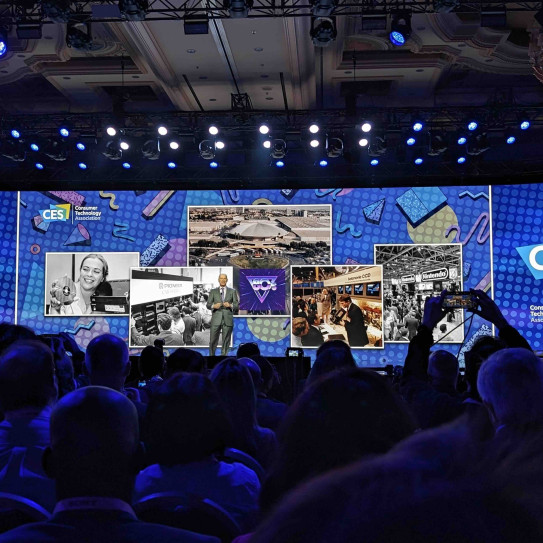
NRF 2024: How AI and composable commerce are revolutionising the customer experience
Following on from CES in Las Vegas, the NRF in New York brought together the key players in the retail sector to explore trends in the sector. The event highlighted a paradox: consumers are yearning for human interaction in-store, while turning to digital, composable commerce and Artificial Intelligence for a seamless customer experience.
Positive commerce for a smoother customer experience
From in-store consumption to e-commerce growth
Over the past two decades, the commerce landscape has undergone a major transformation: before, there was the “old normal” – the realm of brick & mortar – where most purchases were made in stores and e-commerce websites were considered to play a supporting role; now, we have witnessed the transition into a period described as the “new normal”. The outbreak of the COVID-19 pandemic triggered a radical change in consumption habits, pushing e-commerce platforms to the front of the stage as the “go-to” solution to allow people to shop without leaving home. This transition accelerated the move to digital in the retail sector.
Today, we are entering the age of “profitability”, where e-commerce is becoming essential to grow and meet the ever greater expectations of connected and demanding consumers.
Tech’s role as the partner of a phygital customer experience
Another key part of Positive Commerce is the growing need to gather data and integrate new technologies. The aim is not just to increase sales, but to increase the efficiency of sales and make customers’ lives easier.
For example, US retailer Walmart is offering a checkout-free purchasing experience for members of Sam’s Club, its chain of warehouse retail stores. An arch placed at the store exit, fitted with sensors (video, weight, NFC, etc.) combined with AI capabilities (computer vision), is able to identify a trolley’s content and automatically bill the customer account. These technologies can be found everywhere, from logistics to connected labels and checkout tools. Digital solutions providers like VusionGroup (formerly SES-Imagotag) are integrating AI-driven tech to make stores smarter, including automated management of special offers, shelf surveillance to optimise product availability and real-time inventory management.
Generative AI for a smoother consumer experience
Within this ecosystem, one technology stands out from the rest: generative AI. It can be found in many use cases:
-
Product comparison: AI can summarise and present differences between several products, making it faster and easier for buyers to choose the product best suited to their needs.
-
Product reviews: generative AI evaluates products based on opinions shared by users.
-
Buying guides: AI gives personalised advice to facilitate the buying experience.
-
Conversational interface: a friendly chatbot uses the power of generative AI to offer helpful and engaging interactions.
The South American online marketplace @MercadoLibre uses AI in its digital platform to categorise, moderate, recommend, optimise prices and stocks, and prevent fraud (see image). This company is going even further with the integration of generative AI. It has introduced a chatbot (personal shopper) to enhance the buying experience and provide augmented customer support through comprehensive summaries of customer interactions. It is also developing its own assistant, FuryCopilot, for the generation of code, tests and documentation.
Another key way that tech can make customers’ lives easier is through new solution architectures that have the flexibility needed to adapt to new customer behaviours.
Composable commerce for greater flexibility
In this age of profitability, one of the main challenges for all brands and retailers is to optimise the value chain, beginning with the information system. The aim is to reduce structural costs while continuing to ensure customer satisfaction. Modern, modular architectures, described as ‘composable’, are an effective way to achieve this aim.
What is composable commerce?
This architecture is built on an array of cutting-edge components, aligned with the principles of the MACH Alliance (micro-services, API-first, cloud-native SaaS, headless). It includes a high level of APIsation in the information system to ensure interoperability between the various systems, and adopts a cloud-first approach to make the transformation smoother and faster. This approach also involves a data-driven strategy to create a lasting architecture.
A particularly striking aspect of the NRF show was the widespread acceptance of the composable concept’s potential, not only among publishers (from CMS to search engines and e-commerce) and IT managers, but also on the business side. They all seem to have been won over by the flexibility and optimised maintenance that composable solutions bring through their modular approaches. At the same time, these actors are aware of the pragmatism needed to implement them.
Composable architecture in the area of e-commerce
This is especially true in the area of e-commerce. As Mariano Gomide de Faria (co-founder of VTEX) emphasised, flexibility and maintenance are the keys to success. Flexibility makes it possible to handle changes in technology and the behaviours of increasingly demanding consumers with greater ease, while optimised maintenance improves control of structural costs. You can choose to create an entirely customised architecture (monolithic), which inevitably leads to computing complexity and high maintenance overheads; alternatively, you can adopt a pragmatic approach with composable commerce, by integrating interoperability issues very early on and taking into account the organisational impacts of this product-centred architecture. These are two decisive ways to ensure the success of such a transformation.
Following on from the CES tech innovation trade show, it was no surprise to see the retail and e-commerce sectors embrace the major emerging trend of generative AI. This technology is however incorporating a more human dimension through a return to physical stores. This does not mean that there is a move away from the digital realm; in fact, digital tech needs to support these new uses and many more to come with the growth of AI. This is why we need to transition from monolithic architectures, which are good at meeting given needs at given times, towards the greater flexibility offered by composable architectures. This approach does involve compromises though, such as the management of system interoperability and organisational impacts. A lot of work still lies ahead for architecture experts.

